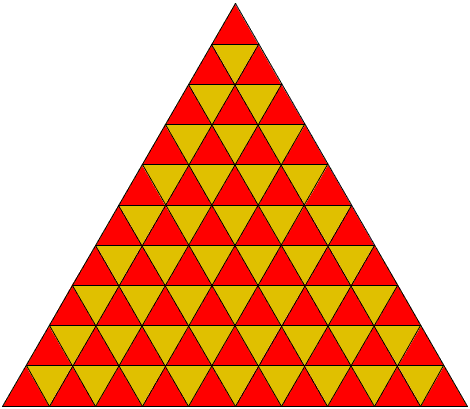A triangular board has been cut into 100 small triangular cells by the lines parallel to its sides. Two cells that share a side are said to be neighbors. All at once, the grasshoppers hop from their cells to neighboring cells. This happens 9 times. Prove that at least 10 cells are now empty.
Solution

The board is naturally colored into two colors so that the neighboring cells are colored differently. Let the colors be red and brown and label the grasshoppers by the color of their cells. Convince yourself that there are 55 red and 45 brown cells. In one hop, the brown grasshoppers move to the red cells thus emptying 55 cells. On the same hop, the brown grasshoppers move to the red cells thus filling at most 45 red cells. Inevitably, at least 10 red cells will remain empty.
The next time the grasshoppers move, they can move into their original cells, thus filling all of them. The situation will return to the original one, while the argument will apply to every odd hop. Perhaps there may happen a greater mix-up of the red and brown hoppers, but the best that may be claimed is that after every odd hop, there are at least 10 empty cells.
In general, there are n(n+1)/2 red cells and n(n-1)/2 brown cells. The difference being n(n+1)/2 - n(n-1)/2 = n, there are always at least n empty cells after an odd number of hops.
The specific number of hops (9) is nothing but a red herring.
Note: the discrepancy between the two kinds of cells in the general partition of a triangle into smaller ones, shows up in a different problem.






{ 0 comments... Views All / Send Comment! }
Post a Comment
Please comment politely.